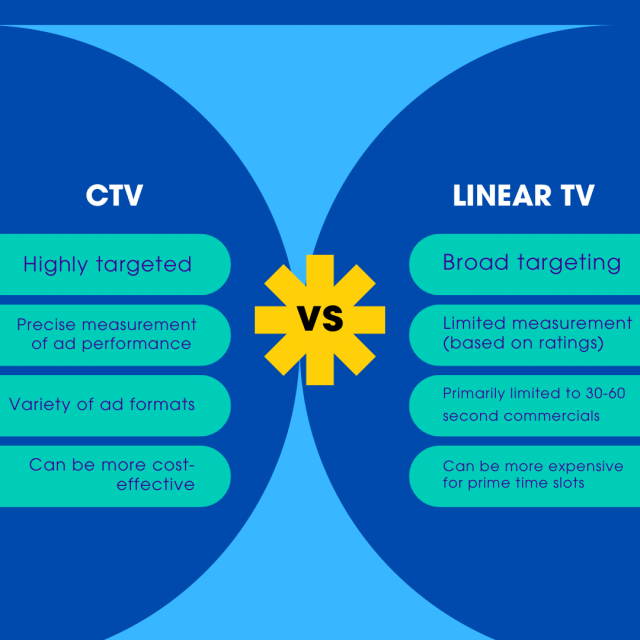How do you watch TV in your home? I am sure, like me, you enjoy the convenience of streaming from your favorite services.
This may be no surprise, as Leichtman Research Group reports that 88% of US households own at least one Internet-connected TV device (e.g. smart TV, streaming device like Roku or Amazon TV Fire Stick, gaming console, etc). Almost half (49%) of US adults watch these connected TVs daily
Thanks to various streaming platforms, the way people enjoy their favorite movies and shows has completely changed. As a result, advertising has had to evolve and follow suit, giving rise to connected TV (CTV), a dynamic and data-driven advertising approach that’s capturing the attention of marketers worldwide.
If you haven’t considered adding CTV advertising to your marketing strategy, it’s time to consider it.
What is CTV?
Connected TV (CTV) refers to any television set or device that connects to the internet and allows users to stream video content.
This encompasses a wide range of devices. It includes smart TVs, streaming media players such as Roku and Amazon Fire, and even gaming consoles that offer streaming services.
CTV bridges the gap between traditional television and the digital world, enabling you to access a vast library of content.
CTV vs. Linear TV
CTV and linear TV represent two very distinct approaches to television advertising.

Linear TV, the traditional model, broadcasts ads to a wide audience within a specific time slot, offering limited targeting beyond basic demographics and geographic location. Linear TV still accounts for almost six times as many ad impressions as CTV, making it the right channel for upper-funnel messaging.
On the other hand, CTV advertising leverages the power of data to deliver extremely targeted messages to specific households. This precision targeting, coupled with engaging ad formats, makes CTV a powerful and increasingly important channel for you to have in your marketing strategy.
Why is CTV Advertising Important?
CTV advertising has burst onto the scene, swooping in to save businesses from the perils of aimless advertising. It can be an extremely effective way for businesses to reach a wide and engaged audience:
- 46% say it offers advanced audience targeting opportunities.
- 45% say CTV advertising improves ad spend efficiency.
- 43% say it’s proven to drive higher ad conversions.
Here’s why it’s important:
Robust Targeting Capabilities
Nearly one third of U.S. viewers also used their CTV devices to complete a purchase after viewing an ad.
Unlike traditional TV advertising, CTV can allow you to target very specific demographics, interests, and behaviors.
This precision targeting ensures that your ad reaches the right people at the right time.
Reaches Cord-Cutters
By the end of 2025 cord cutters will comprise 72% of U.S. households.
With the rise of the streaming trend, many consumers are shifting from traditional cable TV to services, such as Netflix, Disney+, Amazon, HBO, Paramount+, Peacock, and so many others.
Because of this major shift, CTV advertising enables you to reach your audience on whatever device they’re viewing from.
Measurable Results
CTV advertising provides detailed analytics, allowing you to track the performance of your campaigns and measure key metrics such as impressions, clicks, and conversions.
Engaging Ad Formats
CTV supports a variety of ad formats, including skippable and non-skippable video ads, interactive ads, and full-screen ads, providing opportunities for creative and impactful campaigns.
Types of CTV Ads
1. Linear TV Ads
These are traditional TV ads that are delivered through a cable or satellite TV provider. While they still have a significant reach, they lack the targeting capabilities of CTV ads.
Key Characteristics:
Scheduled Broadcast: Airs during specific time slots within a television program.
Broad Reach: Reaches a large audience watching the channel at that time.
Limited Targeting: Targeting is limited to the channel’s overall viewership demographics.
Standardized Format: Typically, 30-second or 60-second spots.
2. Digital Video Ads (DVAs)
These are ads that play before, during, or after digital video content. DVAs can be skippable or non-skippable and can be targeted to specific audiences.
Key Characteristics:
Targeted Reach: Unlike traditional TV, DVAs offer highly targeted reach. You can precisely define your target audience based on demographics, interests, browsing behavior, and other relevant data points.
Interactive Elements: Many DVAs incorporate interactive elements, such as clickable calls-to-action, skippable options, and even interactive games. This allows for greater engagement from your audience and a more dynamic viewing experience.
Measurable Results: DVAs provide detailed performance metrics, such as view rates, click-through rates, and conversion rates. This data will allow you to track the effectiveness of your campaigns and make data-driven adjustments.
Variety of Formats: DVAs come in various formats, including pre-roll, mid-roll, and post-roll ads, as well as in-stream and out-stream ads. This flexibility allows you to choose the format that best suits your campaign objectives and target audience.
3. Addressable TV Ads
This type of advertising allows you to target specific households based on their viewing habits, demographics, and interests.
Key Characteristics:
Precision Targeting: Unlike traditional TV, which broadcasts the same ads to all viewers in a given market, addressable TV allows you to pinpoint specific households based on a wide range of factors. This includes demographics (age, gender, income), interests (hobbies, lifestyle), viewing behavior (past viewing history, preferred channels), and even purchase history.
Personalized Messaging: This precision enables you to deliver highly personalized messages to individual households. For example, a car manufacturer could target households with young families with ads for minivans, while a luxury goods brand could target high-income households with ads for their latest collection.
Data-Driven Approach: Addressable TV ads rely heavily on data to identify and target specific audiences. This data can come from various sources, including set-top box information, household surveys, and online browsing behavior.
Improved ROI: By reaching the most receptive audiences with your relevant messages, addressable TV advertising can significantly improve return on investment (ROI) compared to traditional TV advertising.
Dynamic Creative Optimization (DCO): Addressable TV enables the use of DCO, where ads are dynamically adjusted based on real-time data and viewer behavior. This allows for highly personalized and engaging ad experiences.
Now that you’ve had a glimpse into the exciting world of CTV advertising, you might want to consider this extremely targeted method of getting in front of your audience.
With CTV, you’re not just broadcasting; you’re having a targeted conversation with your ideal viewer.
For more information and ideas for your CTV advertising campaigns, contact Welcome Wagon! Founded in 1928 to welcome new movers to their community, Welcome Wagon is committed to connecting with new homeowners through their mailboxes and online.



